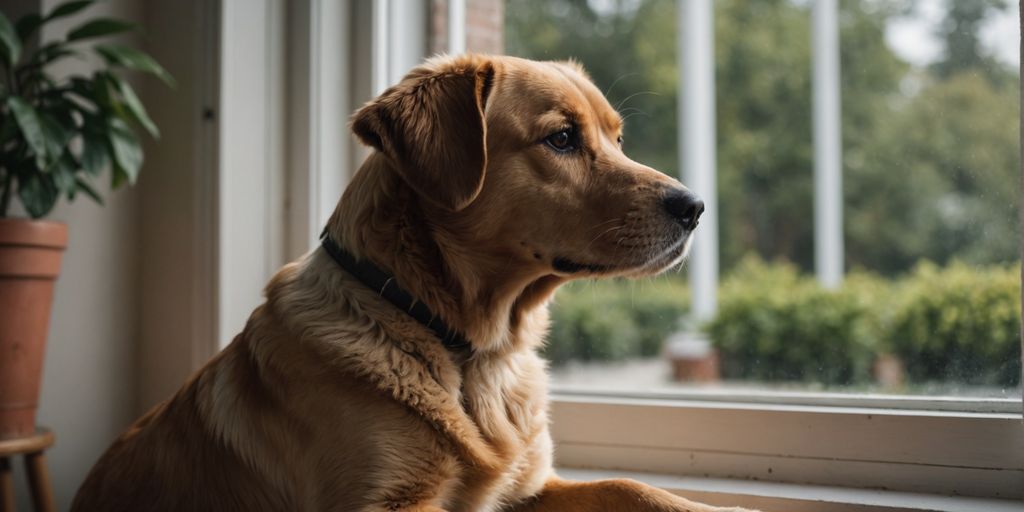Separation anxiety in dogs is a common issue that many pet owners face. It can be tough to see your furry friend stressed out when you leave the house. Understanding and managing this anxiety is key to ensuring your dog stays happy and healthy. This guide will help you recognize the signs of separation anxiety, create a comfortable environment, use effective training techniques, and know when to seek professional help. Let's dive into how you can support your dog through this challenging time.
Key Takeaways
- Recognize the signs of separation anxiety, such as excessive barking, destructive behavior, and clinginess.
- Create a safe and cozy space for your dog with familiar items and calming aids.
- Use training techniques like gradual desensitization and positive reinforcement to ease anxiety.
- Ensure your dog gets plenty of exercise and mental stimulation to reduce stress.
- Seek professional help from a veterinarian or dog behaviorist if needed.
Recognizing the Signs of Separation Anxiety in Dogs
Common Behavioral Indicators
Recognizing separation anxiety in dogs starts with observing their behavior. Excessive barking or howling when left alone is a common sign. Dogs may also chew on furniture or scratch at doors. These actions are not just signs of boredom but can indicate deeper distress. Pacing or restlessness is another indicator. Some dogs might even try to escape from the house or crate.
Physical Symptoms to Watch For
Physical symptoms can also signal separation anxiety. Look for excessive drooling or panting. Some dogs might have accidents in the house, even if they are house-trained. A change in appetite, either eating too much or too little, can also be a sign. Additionally, some dogs may follow you relentlessly, showing their discomfort when you're about to leave.
Differentiating from Other Issues
It's important to differentiate separation anxiety from other issues. For instance, a chewed-up shoe might be a sign of boredom rather than anxiety. If your dog shows signs of depression or lethargy only when you're about to leave, it could be separation anxiety. Always consider consulting a veterinarian to rule out other health problems that might contribute to these behaviors.
Creating a Safe and Comfortable Environment
Designing a Cozy Space
Creating a cozy space for your dog is essential. Dogs need a place where they feel safe and secure. This could be a specific area in your home or a crate. Make sure to include their favorite toys and a comfy bed. Adding an old shirt with your scent can also help them feel more at ease.
"Unlock the Secrets to a Blissful, Healthier Puppy: Discover the Benefits of Holistic Housebreaking"
Using Calming Aids
Calming aids can be very helpful in reducing your dog's anxiety. There are various options available, such as calming sprays, diffusers, and even special anxiety wraps. These aids can create a more relaxed environment for your dog.
The Role of Routine
Just like us, dogs thrive on routine. A consistent schedule for meals, walks, and playtime can help your dog feel more secure. They will know what to expect and when, which can significantly reduce their anxiety. Routine is key to a happy and calm dog.
Training Techniques to Alleviate Anxiety
Gradual Desensitization
Gradual desensitization is a method where you slowly get your dog used to being alone. Start with very short absences and gradually increase the time. This helps your dog understand that being alone is temporary and not something to fear.
- Short Absences: Begin with absences so brief that your dog doesn’t become anxious, then slowly extend the time.
- Predictable Patterns: Use a specific routine before leaving to signal to your dog that you’ll return. Over time, these cues can help reduce their anxiety.
Counterconditioning Strategies
Counterconditioning involves changing your dog's emotional response to being alone. This is done by associating your departure with something positive, like a treat or a favorite toy. The goal is to turn a negative experience into a positive one.
- Positive Associations: Give your dog a special treat or toy only when you leave, so they start to look forward to it.
- Consistency: Make sure to use the same treat or toy each time to build a strong positive association.
Positive Reinforcement Methods
Positive reinforcement is all about rewarding good behavior to encourage it to happen again. When your dog stays calm while you're away, reward them with treats, praise, or playtime.
- Rewards: Use treats, toys, or praise to reward your dog for calm behavior.
- Timing: Give the reward immediately after the desired behavior to reinforce the connection.
Remember, patience and consistency are key. Training your dog to manage separation anxiety takes time, but the results are worth it. Your dog will feel more secure and less anxious, making life better for both of you.
The Importance of Exercise and Mental Stimulation
Daily Physical Activities
Regular physical activity is crucial for your dog's overall well-being. A tired dog is a happy dog, and daily exercise helps burn off excess energy that might otherwise manifest as anxiety or destructive behavior. Here are some activities to consider:
- Morning Walks: Start the day with a brisk walk to get your dog's energy flowing.
- Fetch and Tug-of-War: These interactive games are great for both physical and mental stimulation.
- Swimming: Ideal for dogs who love water and need a low-impact exercise option.
- Playdates: Socializing with other dogs can provide both physical exercise and mental enrichment.
Interactive Toys and Games
Mental stimulation is just as important as physical exercise. Engaging your dog in activities that challenge their mind can help reduce anxiety and keep them occupied. Here are some ideas:
- Puzzle Toys: These toys require your dog to solve a puzzle to get a treat, keeping their mind engaged.
- Treat-Dispensing Toys: Toys like KONGs can be filled with treats or peanut butter to keep your dog busy for hours.
- Hide and Seek: Hide treats around the house and let your dog find them. This game taps into their natural hunting instincts.
- Training Sessions: Short, fun training sessions can be a great way to mentally stimulate your dog while reinforcing good behavior.
Mental Challenges for Your Dog
Keeping your dog's mind sharp is essential for their emotional health. Activities that challenge their brain can help reduce stress and make them more adaptable to new situations. Consider these options:
- Obedience Training: Regular training sessions can improve your dog's focus and discipline.
- Agility Courses: Setting up a mini obstacle course in your backyard can be a fun way to challenge your dog physically and mentally.
- Scent Work: Teach your dog to find hidden objects using their sense of smell. This can be both fun and rewarding for them.
Consistency is key. Stick to a routine that fits your schedule and your dog's needs. This will help maintain their physical and emotional well-being.
By incorporating these activities into your dog's daily routine, you'll not only help them stay fit but also keep their mind sharp and engaged. A well-exercised and mentally stimulated dog is less likely to suffer from separation anxiety and more likely to be a happy, well-adjusted pet.
When to Seek Professional Help
Consulting a Veterinarian
If your dog's anxiety doesn't improve with basic strategies, it might be time to consult a veterinarian. They can perform a thorough check-up to rule out any underlying health issues. In severe cases, they might suggest medication to help manage your dog's anxiety. This can be a game-changer for dogs who haven't responded to other methods.
Working with a Dog Behaviorist
A certified dog behaviorist can offer specialized training plans tailored to your dog's needs. They will assess your dog's behavior and create a plan that includes techniques like desensitization and counterconditioning. This personalized approach can make a huge difference in your dog's progress.
Medication and Supplements
For some dogs, medication or supplements might be necessary to manage their anxiety. Your vet can recommend options that are safe and effective. Anti-anxiety medications can help your dog feel more relaxed and less stressed when you're not around.
Remember, seeking professional help is a positive step towards improving your dog's well-being. Don't hesitate to reach out for expert advice and support.
Building a Stronger Bond with Your Dog
Understanding Your Dog's Needs
To build a strong bond with your dog, it's essential to understand their needs. Dogs are highly sensitive to their owner's emotions, so keeping a positive attitude is crucial. Your calm and patient approach can significantly impact your dog's emotional well-being. Spend time observing your dog's behavior to learn what makes them happy and comfortable.
Effective Communication Techniques
Communication is key to any relationship, including the one with your dog. Use clear and consistent commands to avoid confusion. Positive reinforcement, like treats and praise, can encourage good behavior and build trust. Remember, your dog looks to you for guidance, so be consistent and patient.
The Power of Patience and Consistency
Patience and consistency are vital in building a strong bond with your dog. Training takes time, and there will be setbacks. Stay patient and keep a routine. Over time, your dog will learn to trust you and feel more secure. This process can deepen your relationship, fostering a foundation of trust and mutual respect.
Remember, a strong bond with your dog not only makes them happier but also helps in managing issues like separation anxiety more effectively.
Conclusion
Dealing with separation anxiety in dogs can be challenging, but it's definitely manageable with the right approach. By understanding your dog's needs and providing consistent care, you can help them feel more secure and less anxious when you're not around. Remember, patience and persistence are key. With gradual training, a calm environment, and lots of love, you can strengthen the bond with your furry friend and create a happier, healthier life for both of you. So, take the first step today and start making a positive change for your dog's well-being!
Frequently Asked Questions
What are the common signs of separation anxiety in dogs?
Common signs include excessive barking, destructive chewing, attempts to escape, and accidents inside the house. Some dogs may also drool, pant, or pace when they are anxious.
How can I create a safe space for my dog when I'm not home?
Designate a specific area with your dog's bed, favorite toys, and a piece of clothing that smells like you. This can help your dog feel more secure and comfortable.
What training techniques can help reduce separation anxiety?
Gradual desensitization, counterconditioning, and positive reinforcement are effective methods. Start with short absences and gradually increase the time you are away, rewarding your dog for staying calm.
How important is exercise for a dog with separation anxiety?
Exercise is very important. Regular physical activities like walks and playtime help burn off energy and reduce anxiety. Mental stimulation through puzzle toys and games is also beneficial.
When should I seek professional help for my dog's separation anxiety?
If your dog's anxiety is severe or not improving with home methods, it's a good idea to consult a veterinarian or a dog behaviorist. They can provide specialized advice and may suggest medication or supplements.
Can separation anxiety in dogs be completely cured?
While some dogs may overcome separation anxiety completely, others may only improve. Consistent training, a supportive environment, and possibly professional help can significantly reduce symptoms.


